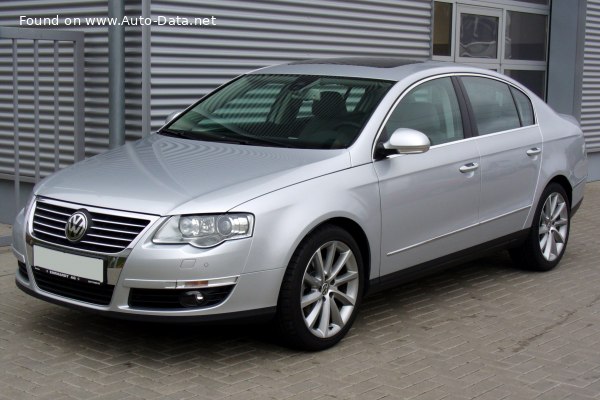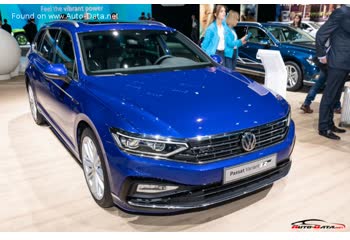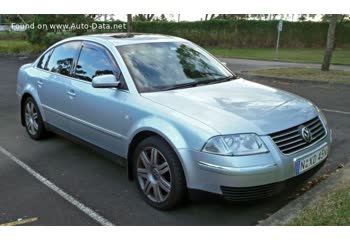Everything you need to know about specifications and performance - Volkswagen Passat 2009 - 1.4 TSI (150 Hp) EcoFuel

Overview:
What is the engine capacity of a Volkswagen Passat 2009?
The engine capacity of the Volkswagen Passat 2009 is 1390.
Volkswagen Passat 2009 How many horsepower?
The engine power of the Volkswagen Passat 2009 is 150 Hp @ 5500 rpm..
What is the Volkswagen Passat 2009 engine?
Volkswagen Passat 2009 engine is EA111 / CDGA. (Click to see other cars using the same engine)
How much gasoline does a Volkswagen Passat 2009 consume?
The Volkswagen Passat 2009 consumes 7.2 liters of gasoline per 100 km
General:
Brand: Volkswagen
Model: Passat
Generation: Passat (B6)
Modification (Engine): 1.4 TSI (150 Hp) EcoFuel
Start of production: 2009
End of production: 2010
Powertrain Architecture: Internal Combustion Engine
Body type:Sedan
Seats: 5
Doors: 4
Engine:
Power: 150 hp @ 5500 rpm.
Power per litre: 107.9 hp/l
Torque: 220 nm @ 1500-4500 rpm.
Engine Model/Code:EA111 / CDGA
Engine displacement: 1390
Number of cylinders: 4
Engine configuration: Inline
Number of valves per cylinder: 4
Fuel injection system: Direct injection and Multi-port manifold injection
Engine aspiration: turbocharging and Supercharger, Intercooler
Valvetrain: DOHC
Engine oil capacity: 3.6 l
Engine layout: Front, Transverse
Cylinder Bore: 76.5 mm
Piston Stroke: 75.6 mm
Compression ratio: 10:1
Performance:
Fuel Type: Petrol / CNG
Fuel consumption (economy) - urban: 9.6 l/100 km
Fuel consumption (economy) - extra urban: 5.7 l/100 km
Fuel consumption (economy) - combined (NEDC): 7.2 l/100 km
Fuel consumption (economy) - urban (NEDC): 9.6 l/100 km
Fuel consumption (economy) - extra urban (NEDC): 5.7 l/100 km
Fuel consumption (economy) - urban (CNG): 6.1 kg/100 km
Fuel consumption (economy) - extra urban (CNG): 3.5 kg/100 km
Fuel consumption (economy) - combined (CNG): 4.5 kg/100 km
Fuel consumption (economy) - urban (CNG) (NEDC): 6.1 kg/100 km
Fuel consumption (economy) - extra urban (CNG) (NEDC): 3.5 kg/100 km
Fuel consumption (economy) - combined (CNG) (NEDC): 4.5 kg/100 km
Fuel consumption (economy) - combined: 7.2 l/100 km
Emission standard: Euro 5
Acceleration 0 - 100 km/h: 9.8 sec
Acceleration 0 - 62 mph: 9.8 sec
Maximum speed: 210 km/h
Weight-to-power ratio: 10.2 kg/Hp, 98.2 Hp/tonne
Weight-to-torque ratio: 6.9 kg/Nm, 144.1 Nm/tonne
Acceleration 0 - 60 mph: 9.3 sec
Space:
Kerb Weight (kg): 1527
Max. weight (kg): 2100
Max. roof load: 100 kg
Max load (kg): 573
Trunk (boot) space - maximum: 1011 l
Trunk (boot) space - minimum: 485 l
Permitted trailer load with brakes (12%): 1500 kg
Fuel tank capacity: 31 l
CNG cylinder capacity: 21 kg
Permitted trailer load without brakes: 750 kg
Permitted towbar download: 90 kg
Permitted trailer load with brakes (8%): 1700 kg
dimensions:
Ramp-over (brakeover) angle: 10.8°
Length: 4765 mm
Width: 1820 mm
Height: 1472 mm
wheelbase: 2709 mm
Width including mirrors: 1991 mm
Front track: 1552 mm
Rear (Back) track: 1551 mm
Ride height (ground clearance): 114 mm
Minimum turning circle (turning diameter): 11.4 m
Approach angle: 14.4°
Departure angle: 12.6°
Powertrain, Suspension and Brakes:
Drivetrain Architecture: The Internal combustion Engine (ICE) drives the front wheels of the vehicle.
Drive wheel: Front wheel drive
Number of gears and type of gearbox: 6 gears, manual transmission
Front brakes: Ventilated discs
Rear brakes: Disc
Assisting systems: ABS (Anti-lock braking system)
Steering type: Steering rack and pinion
Power steering: Electric Steering
Tires size: 205/55 R 16
Wheel rims size: 6.5 J x 16
Front suspension: Independent type McPherson, Transverse stabilizer
Rear suspension: Independent multi-link suspension, Transverse stabilizer
See also

Last generation.
Its production began in 2019 until 2023

Other generation.
Its production began in 2001 until 2004

Same engine. (EA111 / CDGA).
Its production began in 2009 until 2010

Write a comment